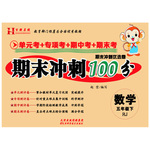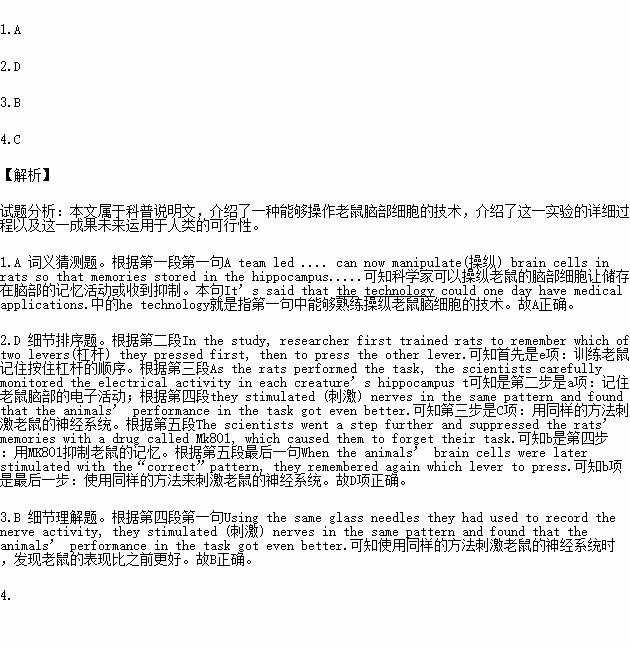题目内容
A team led by Professor Theoder Berger, from the University of Southern California, can now manipulate(操纵) brain cells in rats so that memories stored in the hippocampus, a brain area crucial for memory formation, are activated or suppressed(抑制). It’s said that the technology could one day have medical applications.
In the study, researcher first trained rats to remember which of two levers(杠杆) they pressed first, then to press the other lever.
As the rats performed the task, the scientists carefully monitored the electrical activity in each creature’s hippocampus to find the pattern of nerve-cell activity involved in making a solid memory.
Using the same glass needles they had used to record the nerve activity, they stimulated (刺激) nerves in the same pattern and found that the animals’ performance in the task got even better. The rats made fewer errors and were able to remember which lever was the“correct”one for a longer period of time.
The scientists went a step further and suppressed the rats’ memories with a drug called Mk801, which caused them to forget their task. When the animals’ brain cells were later stimulated with the“correct”pattern, they remembered again which lever to press.
“What’s really exciting about this study is that when they played back the‘good’ patterns—the patterns when the animal got the task right—it did appear to improve memory,”said Dean Buonomano, an associate professor at the University of California.
The final goal, Berger said, is to help people with stroke(中风) and epilepsy(癫痫症) and the like strengthen memories and to help doctors treat them. The technology might even help sufferers of post-traumatic(创伤后) stress disorder.
But first, researchers would have to show that they can stimulate or suppress far more complex memories than the ones in the rat experiment.
“Here ,it’s a simple task,”Buonomano said. In contrast, humans’ memories are very rich and specific…
“We have very many steps to go before this can be achieved,”he said.
1.How does“the technology”in Paragraph 1 act?
A.It manipulates brain cells.
B.It stores memories in the hippocampus.
C.It activates memories stored in the brain.
D.It suppresses memories stored in the brain.
2..In what order did the researchers conduct the rat experiment?
a.Monitor the electrical activity in the rat’s hippocampus.
b.Suppress the rat’s memory with a drug called MK801.
c.Stimulate the rat’s nerves in the same pattern.
d.Stimulate the rat’s nerves in the same pattern for a second time.
e.Train the rats to remember the order of the two levers they pressed.
A.a, e, b, c, d B.a, e, c, d, b
C.e, a, c, d, b D.e, a, c, b, d
3.When their nerves were stimulated, the rats .
A.forgot their task
B.completed the task better
C.made no errors in their task
D.remembered which lever they had pressed for a shorter time
4.What can we infer from the article?
A.MK801 is a drug that can be used to stimulate nerves.
B.The study is expected to be used to help stroke and epilepsy patients recover completely.
C.Using the study to improve humans’ memories still face many challenges.
D.Researchers have studied far more complex memories than the ones in the rat experiment.
 99加1领先期末特训卷系列答案
99加1领先期末特训卷系列答案 百强名校期末冲刺100分系列答案
百强名校期末冲刺100分系列答案 好成绩1加1期末冲刺100分系列答案
好成绩1加1期末冲刺100分系列答案 金状元绩优好卷系列答案
金状元绩优好卷系列答案
